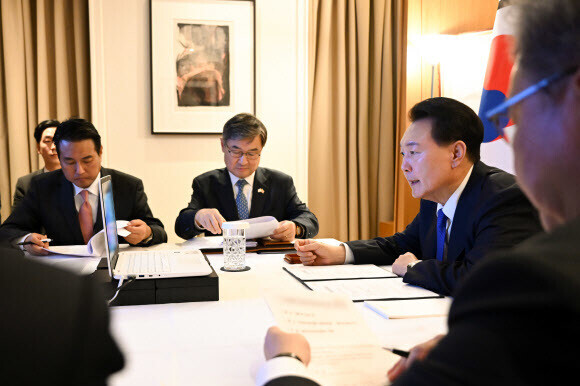hankyoreh
Links to other country sites 다른 나라 사이트 링크
Seoul moves to partially suspend buffer-creating inter-Korean military accord signed in 2018

In response to North Korea launching a military spy satellite on Tuesday night, the South Korean government has moved to partially suspend the inter-Korean military pact signed on Sept. 19, 2018. South Korea has also decided to restore military surveillance in the border region around the Military Demarcation Line (MDL) that divides the two Koreas.
South Korean President Yoon Suk-yeol, currently on a state visit to the United Kingdom, made such decisions during an emergency meeting of the standing committee of the National Security Council (NSC). On Wednesday morning, South Korean Prime Minister Han Duck-soo headed a Cabinet meeting, where members were expected to review and approve a partial suspension of the Sept. 19 inter-Korean military pact.
On Tuesday, Yoon held a video conference with the National Crisis Management Center with his team in London to preside over the NSC meeting. The presidential office has announced that Yoon and his staff discussed response measures after the chairman of the Joint Chiefs of Staff reported to the president on the situation regarding the satellite launch.
“Regardless of its success, North Korea’s launch of a military spy satellite represents its intention to increase its surveillance of South Korea and to bolster its intercontinental ballistic missile capacity. These measures are meant to counter the threat of North Korea’s nuclear weapons and missiles,” Yoon said during the meeting.
The NSC standing committee issued a separate statement. “In spite of several warnings from the international community, North Korea launched a military spy satellite,” the council’s statement read. “Restrictions placed on South Korea by the Sept. 19 military agreement now present a security threat to our border regions.”
“The South Korean government is therefore pursuing a suspension of Article 1, Clause 3 of the Sept. 19 agreement. We will also resume surveillance of North Korean activity in regions along the MDL, which was discontinued as a result of the Sept. 19 military agreement,” the NSC announced.
Article 1, Clause 3 of the Sept. 19 comprehensive military agreement forbids the flight of any fixed-wing aircraft within 40 km of the MDL along the eastern front and 20 km along the western front. The pact also forbids the flight of any rotary-wing aircraft (helicopter) within 10 km of the MDL; unmanned air vehicles (drone) within 15 km of the MDL along the eastern front and 10 km along the western front; and hot-air balloons within 25 km of the MDL. In short, the South Korean government has announced its intention to resume surveillance activity within the MDL region.
The military pact, formally known as the “Agreement on the Implementation of the Historic Panmunjom Declaration in the Military Domain,” was signed by President Moon Jae-in and North Korean leader Kim Jong-un on Sept. 19, 2018, during their inter-Korean summit. The two leaders agreed to cease all hostile activity by land, air, and sea and create a buffer zone between the two Koreas.

Yoon ordered the lawful execution of all countermeasures he discussed with the NSC standing committee.
The prime minister’s office announced that Han convened and headed an extraordinary Cabinet meeting at the Seoul government complex at 8 am on Wednesday to discuss the partial suspension of the Sept. 19 inter-Korean agreement. The suspension officially begins after the Cabinet approves it and announces it to North Korea.
The NSC also announced that Yoon will thoroughly prepare countermeasures against further provocation from North Korea, and that the president has ordered the maintenance of a fortified defense posture through the South Korea-US alliance as well as the pursuit of extensive trilateral cooperation with the US and Japan.
The South Korean government is prepared to further suspend the Sept. 19 military accord if the security situation worsens.
“Additional measures regarding articles of the Sept. 19 agreement that are still valid will be determined by North Korea’s behavior going forward,” the NSC announced.
By Bae Ji-hyun, staff reporter
Please direct questions or comments to [english@hani.co.kr]

Editorial・opinion
![[Column] How opposing war became a far-right policy [Column] How opposing war became a far-right policy](https://flexible.img.hani.co.kr/flexible/normal/500/300/imgdb/original/2024/0702/5017199091002075.jpg) [Column] How opposing war became a far-right policy
[Column] How opposing war became a far-right policy![[Editorial] Korea needs to adjust diplomatic course in preparation for a Trump comeback [Editorial] Korea needs to adjust diplomatic course in preparation for a Trump comeback](https://flexible.img.hani.co.kr/flexible/normal/500/300/imgdb/original/2024/0702/9717199086060096.jpg) [Editorial] Korea needs to adjust diplomatic course in preparation for a Trump comeback
[Editorial] Korea needs to adjust diplomatic course in preparation for a Trump comeback- [Editorial] Silence won’t save Yoon
- [Column] The miscalculations that started the Korean War mustn’t be repeated
- [Correspondent’s column] China-Europe relations tested once more by EV war
- [Correspondent’s column] Who really created the new ‘axis of evil’?
- [Editorial] Exploiting foreign domestic workers won’t solve Korea’s birth rate problem
- [Column] Kim and Putin’s new world order
- [Editorial] Workplace hazards can be prevented — why weren’t they this time?
- [Editorial] Seoul failed to use diplomacy with Moscow — now it’s resorting to threats
Most viewed articles
- 110 days of torture: Korean mental patient’s restraints only removed after death
- 2Nine dead in Seoul after car plows into pedestrians
- 3[Editorial] Korea needs to adjust diplomatic course in preparation for a Trump comeback
- 4Korea to create dedicated population strategy ministry to combat low birth rate, aging society
- 5[Editorial] On the revival of Daehan News and theater boycott
- 6Samsung Electronics workers to go on first strike in company’s 55-year history
- 7Japan is building a military meant for more than self-defense — and has the US to thank for it
- 8[Column] How opposing war became a far-right policy
- 9Korean scientists publish research that could be used to development coronavirus treatment
- 10[Editorial] Silence won’t save Yoon